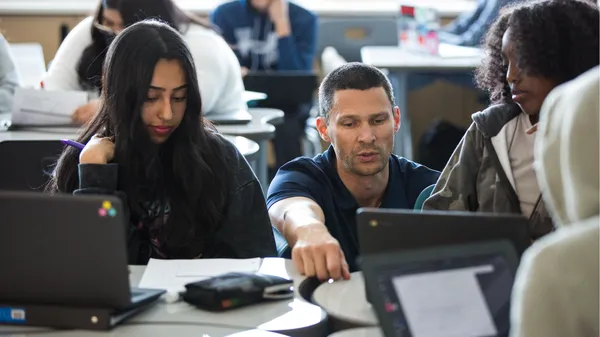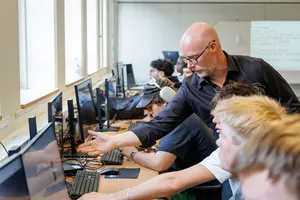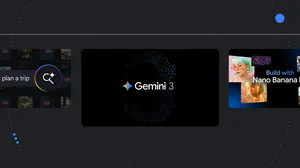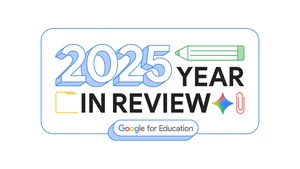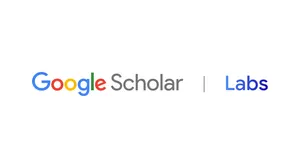AI in education: From accessing information to achieving understanding

Editor's note: Last week we brought together educators, students, academics, researchers, technologists and more at our Google AI for Learning Forum in London in partnership with Google DeepMind. Below are opening remarks from Ben Gomes, Google’s Chief Technologist for Learning and Sustainability. These have been lightly edited for clarity.
Ben Gomes giving opening remarks at the AI for Learning Forum.
YouTube educational creator Gohar Khan moderating a student panel on the future of learning.
Google’s SVP, Research, Labs, Technology & Society James Manyika in conversation with Tony Blair, former British Prime Minister and now leader of the Tony Blair Institute for Global Change.
My name is Ben Gomes. I lead our learning and sustainability at work at Google. I’ve been at Google a long time – 26 years – and for much of that time I worked on Search, which was meant to be the ultimate answer agent. But today, I have more questions than answers. That’s what makes today’s conversation one of the most important of our time — about how AI will affect learning. To get it right, we need to make sure we ask the right questions and take the time to get the right answers. I'll offer a brief view of how we view the landscape of learning across AI.
How learning and technology interact today
First of all, what do we mean by learning? I think learning is the key instinct that sets us apart as a species. As human beings, the fundamental thing we can do is learn from other people. And that allows people to transmit a capability from one person to another and expand the space of human capabilities.
For decades as a society, we’ve been working on translating that instinct to learn into formal educational systems, and there’s been a lot of progress. Today, over 90% of primary school-age children are actually enrolled in primary school, which is really amazing from even a few decades ago. But the progress that we're seeing is uneven. And it's fragile.
We are still seeing learning loss from the pandemic. We saw, for the first time on record, global drops in scores from PISA. These are not small problems. They're deep human problems. We're also seeing problems on the side of the teachers. There’s projected to be a global shortage of 44 million teachers by 2030. Teachers are happy with the work they're doing but a lot of them have burnt out. So we have many challenges to address. And at the same time AI has entered the scene and given machines the ability to manipulate language.
What's special about language is that it's a fundamental tool that's used in learning. With AI there's a possibility of expanding this, the scope of what we can do in learning. But I want to be clear: the fundamental reason we learn is not because of technology. It's because of human beings. That human connection is at the core of learning. That’s why we don't want to replace that central connection of learning. We want to enhance it. That is our North Star.
So, what role does technology then play in the space of learning? Over the decades, the internet and technologies, like Search, actually improved access to information. They removed barriers. But with AI, you can actually change how people interact with information. AI has two great powers that are relevant in the space of learning. One of them is this deep kind of interaction that goes far beyond just getting information. The other is the ability to transform information from one format to another. And we can see the application of these two powers through the lens of the student and the lens of the teacher.
How AI can help students learn
From the perspective of the student, AI can provide the ability to have a deeply personalized learning experience. Imagine a student who's curious, but struggling with a concept or a complex idea. Because of the power of AI to transform content, the student can now get that content in a way in which they can relate to it, and this can make them feel capable of learning anything. They can stay in that zone of proximal development where they are challenged, but not overwhelmed. The models can even help with motivation. They're incredibly good at finding ways to connect one idea to another. They can translate what's on a textbook page — a dry idea — into something that's meaningful to the student, and actually motivate them to learn the concept.
With AI, I can take content and turn it into other immersive formats like podcasts and videos and mind maps. And in doing so, break down long-standing barriers in education for people with learning disabilities and provide access that they have never had before. So, for the first time, we have a tool that can help make anything learnable by anyone.
How AI can help educators focus on what matters most
For educators, AI can be a powerful teaching assistant. It can help overburdened educators who are burning out do a lot of the administrative work: to create lesson plans, to help with their instruction and to create activities for their students. This doesn't replace the work that they're doing — the fundamental connection that they're building — but it aims to free up their time and give them that time to spend with the student. The time to inspire. The time to motivate and create that joy. The time to foster curiosity. And the time to spark a lifelong love of learning.
While AI can help with the learning process, the inspiration still comes from the connection with a person. Almost everybody here has had some experience with a teacher that transformed them. For me, it was my mother, a chemistry teacher, who changed my life and instilled within me a real curiosity to learn and to understand.
So the thing that inspires people is not a book. It's that connection to the person that inspires that love of learning. And when you get teachers who do that together with technology that really works to bring the student along, I think you have magic. And I think we have the potential for many more people around the world to experience a kind of magic that all of us, probably, at some point did. This is the promise.
How we’re tackling the challenges of AI and education
But to realize it, we also have to be clear-eyed about the challenges and the complexities. And they are significant. Technology and technologists have made big promises before. But we can learn from those previous cycles. We have learned that technology itself cannot solve these deep-rooted challenges. It has to be designed with clear pedagogical principles and in partnership with the teachers and students it's trying to serve. This is critical because AI itself is introducing new and urgent challenges.
The first challenge AI introduces is safety. It's a top priority for us to make sure that what we're exposing young learners to is safe for them. We do this through adversarial testing, but also in collaboration with people like you to monitor what's happening in real life so that we can address new challenges that emerge.
Secondly, accuracy. These models have gotten vastly better the last few years in accuracy, but there's still a ways to go, and we continue to work to make these models ever more accurate so that they can gently guide a student from a misconception to the correct understanding and not to another hallucination. The question I hear the most in this context is: what about critical thinking? Will students offload their thinking to the machine? And while I think that's possible, I think we also have the ability to actually help the student in this way.
We know that learning is about productive struggle. That does not mean maximal struggle. If you think about learning as it happens across the world, a lot of the struggle that happens is an unproductive struggle. It's because the content is at the wrong level. It's because it's in the modality that doesn't resonate for the student. It's about topics they don't relate to. AI can help eliminate that unproductive struggle so that the student and the teacher can focus on the most important part of the learning process, which is getting those critical thinking skills that really are at the heart of learning.
And finally, and most importantly, we want universal participation. We have to ensure that these tools are available to everybody around the world. We have to ensure that they don't widen the existing gaps in education. A major challenge might be the 5% problem: the risk that only the most privileged, the richest, the best, most motivated students will benefit from AI and others will get left even further behind. We cannot allow this creation of a new digital divide. This means making models universally accessible around the world and in lots of languages that students are using. But it also means that teachers around the world must get trained on the best practices for learning and using AI themselves.
How we’re approaching AI for learning
So, what is our approach? Our approach is guided by two principles. First, our work is grounded in learning science, because we understand that more technology, bigger models, is not going to be the solution in itself. Our AI models like Gemini are being developed specifically grounded in pedagogical principles. Principles like managing cognitive load, encouraging active learning, and stimulating curiosity. And this program, which we call LearnLM, is infused throughout our models.
The second principle is that the promise of AI can only be achieved by active partnership. Partnership with people like you to enable us to develop these technologies in a way that is most useful and resonant for people around the world.
And finally, we have to make sure that these AI tools are actually achieving the outcomes that we want them to achieve. We are committed to a research and evidence-based approach to learn, to iterate, and to be transparent about what's working and what's not.
As we look ahead, we know that the technology will continue to evolve really rapidly. The biggest challenges will come not just in how we learn, but also in what we have to learn for a future that's being reshaped by AI. In the near term, we need to figure out how AI can be effectively adopted to enhance education. But in the longer term, we need to understand how AI can transform education to serve this changing world that's being shaped by AI. That's the goal of the conversation we'd like to have with all of you today.
Today is about dialogue. It's an invitation to share foresight. To challenge assumptions, including ours. And to begin to chart this unpredictable terrain together, as scientists, as educators, as technologists, as students. We want to learn from each other today. Together, we can shape and steer this technology to be aligned with the highest human goals. For learning and education, the greatest potential of AI is helping everyone reach theirs.
